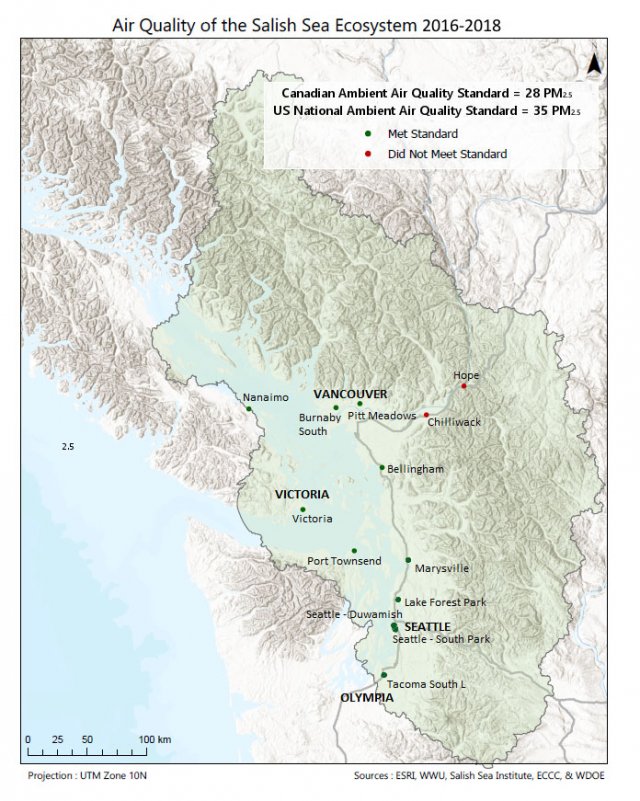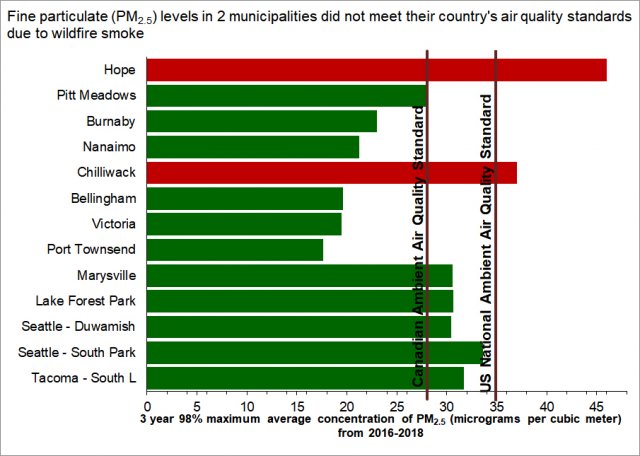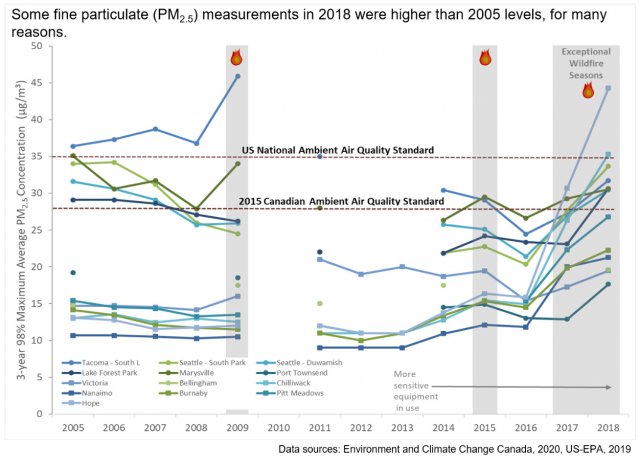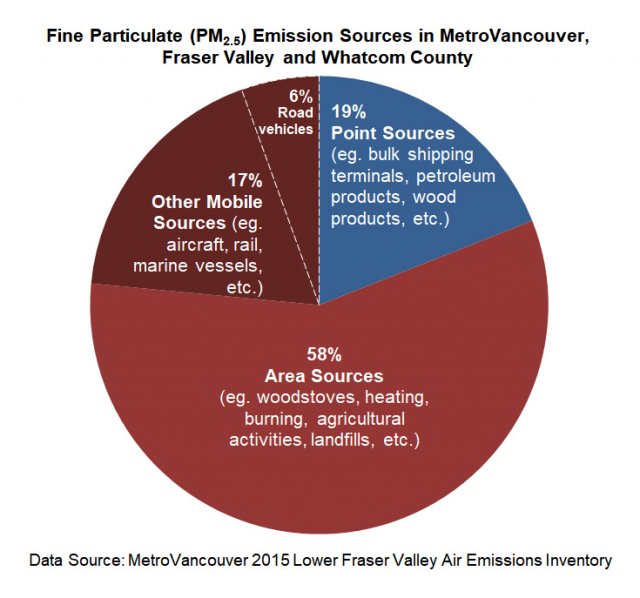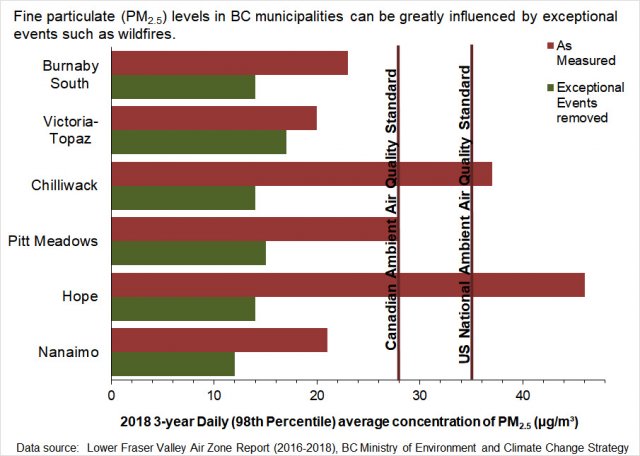Air Quality
Updated June 2021 based on data available through December 2018.
- About Air Quality
- What's Happening?
- Why Is It Important?
- Why Is It Happening?
- What's Being Done About It?
- Five Things You Can Do To Help
- References
About Air Quality
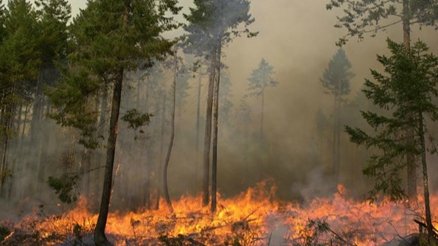
EPA and Environment and Climate Change Canada (ECCC) have set air quality standards for fine particulates such as those found in smoke or haze. These tiny particles, also called PM2.5 because they are 2.5 micrometers in diameter or less, are 30 times smaller than the width of a human hair. Larger particles (PM10) are also transported in air but these heavier particles settle out of the air more quickly compared to PM2.5 particles.
Fine particulates can be inhaled deeply into a person's respiratory system and cause severe health problems. They also contribute to poor visibility, can impact the function of the ecosystem, and are linked to climate change.
What's an airshed?
An airshed is an area where air circulation and pollutant circulation are affected by local basin features such as location of pollutant sources, mountain ranges, open water fetch and temperature differences of underlying lands and waters. The geographic features of the greater basin affect both the dispersion and transport of air masses and pollutants.
The joint Salish Sea airshed includes inputs from the Pacific Ocean, and the circulation patterns across the basins of the Straits of Georgia and Juan de Fuca, and Puget Sound. However, at times, the Salish Sea airshed can receive winds from the east of the Cascades rather than the Pacific, and at these times local air quality can quickly decline.
To learn more about the Georgia Basin-Puget Sound airshed, see ECCC's Georgia Basin-Puget Sound Airshed Characterization Report.
What's Happening?
Usually, the air quality in the Salish Sea area is good. A number of exceptional events impacted air quality over the last three years. In 2018, levels of fine (inhalable) particulates at 6 of the 13 air monitoring stations shown in the map below met both the 2015 Canadian Ambient Air Quality Standard and the U.S National Ambient Air Quality Standard. Levels of fine particulates in Tacoma, Seattle, Bothell, and Marysville exceeded the more stringent Canadian Ambient Air Quality Standard but met the U.S National Ambient Air Quality Standard. Fine particulate levels in Hope and Chilliwack exceeded both the Canadian and U.S. standards in 2018.
Locations of the 13 air monitoring stations studied in this report:
- Bellingham, Washington
- Burnaby South, British Columbia
- Chilliwack, British Columbia
- Hope, British Columbia
- Lake Forest Park, Washington
- Marysville, Washington
- Nanaimo, British Columbia
- Pitt Meadows, British Columbia
- Port Townsend, Washington
- Seattle (Duwamish), Washington
- Seattle (South Park), Washington
- Tacoma, Washington
- Victoria, British Columbia
Compared to 2005, a shift to higher concentrations in the recent years is reported by air quality scientists, coinciding with the changes to newer air quality monitoring equipment in 2013 in some areas of the airshed. The new sensors are able to detect more existing particulates than the older sensor models and therefore report higher concentrations, but are providing better air quality information to the public. Another reason for higher concentrations in the recent years is due to an unprecedented amount of smoke transported into the region from exceptional wildfire events in 2015, 2017, and 2018.
Sustainable Perspectives
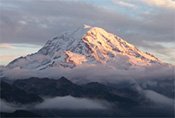
This mountain is at once the most public symbol of the Pacific Northwest and its most sacred private icon. It inspires a feeling akin to spiritual awe: reverence, adoration, and humility.
Mount Rainier National Park is located downwind of many urban and industrial areas, so it is not isolated from the by-products of industrialization. Human-made air pollutants are transported long distances. Stationary and mobile sources of pollution include a variety of sources in the Puget Sound region as far north as Vancouver, and as far south as Portland.
Pollution traveling across the Pacific Ocean from Asia is also deposited in lakes, streams, and on land within the Cascade mountain range at high elevations, affecting chemistry, ecology and the visual perspective of this iconic place.
Why is it Important?
Air quality can affect human health, the environment and the economy. Fine particulates are of special interest for at least three reasons:
- They penetrate deep into the respiratory system and impact human health.
- They play a major role in reducing visibility.
- They can provide a mechanism for the transport and deposition of other chemical pollutants onto our lands and into waters and foodwebs.
Human health effects can occur at even low levels of exposure. Fine particulate matter has been shown to have no minimum safe level. Decreasing the levels of fine particulates in the air in the Salish Sea will improve human health, even though the Salish Sea already has relatively good air quality compared to other urban regions.
Fine particulates can aggravate existing respiratory and cardiovascular disease, reduce lung function, increase respiratory symptoms, and lead to premature death. They can also provide a pathway for toxics, including carcinogens and metals, to enter the body or to be deposited in the environment and enter food webs.
While visibility is of secondary importance compared to the effects to human health and contaminants in the food-web, an observed reduction in visibility due to smog or haze is typically interpreted by the public as air pollution. Tourism is a key economic sector in the Salish Sea ecosystem where visitors are attracted to spectacular coastal vistas, which can be obscured by high levels of particulate matter.
Economic Impacts
The economic benefits of reducing fine particulates are significant. The Border Air Quality Study, an economic assessment led by the University of British Columbia, estimated that a 1% improvement in PM2.5 would yield $29 million in annual savings in the Lower Fraser Valley in 2010.
In Washington, the 2004 annual costs estimated for adult and childhood asthma was $127.8 million. This estimate reflects asthma cases attributable to or triggered by environmental contaminants such as PM2.5 and includes both direct health care costs and indirect costs, such as lost productivity and premature death.
In British Columbia, direct medical costs for asthma were estimated at $54.7 million in 2007.
Source: Georgia Basin - Puget Sound Airshed Characterization Report 2014 - This report was produced by EPA and Environment and Climate Change Canada on the health and socio-economic impacts of poor air quality in the Georgia Basin-Puget Sound region.
Why is it Happening?
Fine particulates can be both directly emitted into the atmosphere or formed within the atmosphere. Sources may be natural (for example sea spray, blowing dust, tree pollen, forest fires) or caused by human activities (such as construction, wood and fossil fuel combustion).
Within the Salish Sea ecosystem, the main human sources of fine particulates are from transportation (cars, trucks, trains, ships), fossil fuel-based industrial and energy facilities and biomass burning, particularly wood burning during winter months.
An emerging source of fine particulates in the Salish Sea area is wildfires. While forest fires are considered a natural source of fine particulates, their recent increases in severity are linked to climate change and are therefore indirectly caused by human activities. Incidences and extent of wildfires are predicted to increase in the coming decades as summers become drier and hotter.
In 2015, an air emissions inventory of Vancouver, the southwest portion of the Fraser Valley, and Whatcom County looked at air pollution from various sources.
Mobile sources (such as cars and other on-road vehicles, trains, and ships) and area sources (such as woodstoves and commercial boilers) represent about 81% of fine particulate emissions. Of this, vehicles travelling on roads make up to 6% of the total particulate emissions.
Point sources (such as large industrial facilities) contribute the remaining 19%.
This emissions inventory does not cover natural releases of particulate matter, which includes emissions from forest fires. Multiple studies have concluded that fine particulate emissions from wildfires have offset remedial actions to improve air quality. Without the influence of wildfires, the overall air quality of the Northwest United States would be improving.
Wildfires have also obscured long-term improving air quality trends in British Columbia according to data analyses by Environment and Climate Change Canada and the BC Ministry of Environment and Climate Change Strategy. Without the influence of wildfire-impacted days in BC, fine particulate levels at all BC air monitoring sites would have met Canadian and US Standards in 2018.
Wildfires
While it is difficult to predict how air quality will be impacted by wildfires in any given year, there are steps that you can take to prepare for and protect yourself from wildfire smoke. Before wildfire season, which is typically in the warm, dry summer months, create a plan that will keep you and your family safe should a wildfire event occur. This could involve stocking up on food, medications, and other necessary items, and identifying nearby “cooling centers”, such as local libraries or community centers that have proper air flow and that can serve as places to visit in order to avoid smoky air.
If a wildfire event takes place and air quality in your region is being impacted, protect yourself from wildfire smoke. Limit your time outdoors to avoid inhaling smoky air. Close windows and doors to keep the air in your home clean, or visit a cooling center if the air in your home is not clean enough, and drink plenty of water to reduce irritation caused by smoky air, and seek medical attention if you experience trouble breathing or if other symptoms attributable to wildfire smoke become severe.
What's Being Done About It?
The Georgia Basin-Puget Sound International Airshed Strategy (IAS) is a multi-agency, international co-operative effort to address shared air quality management concerns through co-operation and information exchange. This strategy also aims to prevent future deterioration of air quality, which is particularly important due to regional population growth and increasing incidence of wildfires.
Key activities under the IAS include the following:
- Prioritizing air quality issues for action by the IAS Working Groups.
- Forecasting future air quality conditions in the airshed.
- Improving the efficiency of air quality data exchange among agencies.
- Improving information exchange and notification procedures for significant new sources of transboundary air pollution.
- Collaborating on regulations to ensure cleaner vehicles and fuels in the region.
Individually, agencies are focused on actions to reduce emission sources from the following sources:
- Locomotives and rail yards.
- Marine vessels and port operations.
- Wood burning.
- Vehicles and non-road engines.
Below are examples of actions to reduce emission sources of fine particulates:
Emission Control Areas in Coastal B.C. and Washington
In 2010, the International Maritime Organization accepted a joint Canada-U.S. application to designate parts of coastal waters in B.C. and Washington as Emission Control Areas. These areas have more strict standards for marine fuels, as well as sulphurous oxide and nitrogen oxide emissions.
In response, Canada amended its regulations for vessel pollution and dangerous chemicals under the Canadian Shipping Act.
Wood Smoke Reduction Efforts in Washington
Washington has some of the most progressive wood smoke reduction laws in the U.S.
Wood and pellet stoves sold in Washington must be nearly twice as clean as the national EPA emission standard. Washington also regulates factory-built fireplaces, masonry heaters and other solid fuel burning devices, and does not permit the sale or installation of outdoor wood-fired boilers.
Burn bans, fuel restrictions (such as no garbage burning) and wood fuel moisture requirements have been in use since 1995.
British Columbia Wood Stove Exchange Program
The B.C. Wood Stove Exchange Program provides financial incentives for upgrading old wood stoves. It also provides education to wood burners on how to improve their burning practices.
In 2014, the provincial government provided $200,000 to support wood stove exchange programs in 13 communities. This funding provided incentives for replacing 700 old smoky wood stoves and education on clean wood burning practices. As of 2016, over 7000 old stoves have been replaced through the program.
Emissions from Non-Road Diesel Engines in Metro Vancouver
New operating prohibitions came into force in 2015 under Metro Vancouver’s Non-Road Diesel Engine Bylaw which has been in effect since 2012. Under the new bylaw, owners and operators of older industrial and construction machines such as excavators, forklifts and generators are required to register and pay fees for engines with no or rudimentary controls. Unregistered engines are prohibited from operating.
Metro Vancouver also offers rebates of up to 80% fees if older engines are retired or upgraded. Port Metro Vancouver launched a similar program for port tenants in 2015.
Learn More
Learn more about regional air quality and some of the work our partners are doing.
- Puget Sound Vital Signs - Air Quality
- Canada - U.S. Border Air Quality Strategy - Including the Georgia Basin-Puget Sound International Airshed Strategy.
- Environment and Climate Change Canada - Air Quality
- B.C. Air Quality
- Metro Vancouver Air Quality and Climate Change
- Puget Sound Clean Air Agency - Wildfire Smoke
- AirNow - Get air quality for where you live (U.S. air stations).
- British Columbia Air Quality Index – Provincial summary and forecasts.
- Wildfire Smoke – B.C. CDC information and tips.
A History of U.S.-Canada Collaboration on Air Pollution in the Salish Sea Airshed
The first significant case of U.S.-Canadian transboundary air pollution, the Trail Smelter Arbitration, also created a global precedent. The smelter began operations in the 1890s in southern British Columbia, near the U.S. border. Soon after, nearby farmers in Washington State complained that sulphur dioxide (SO2) emissions from the plant were damaging their land, livestock, and businesses.
The dispute was pursued through a lengthy legal process that culminated in the Trail Smelter Arbitration. The most important result from this arbitration, which concluded in 1941, was the finding that "no nation may undertake acts on its territory that will harm the territory of another state" - a global precedent in the area of transboundary air pollution.
Another binational environmental effort between Canada and the United States is the International Joint Commission, which was formed in 1909 as part of the Boundary Waters Treaty. Though the Commission originally dealt with water-related issues, it now also considers air quality matters as well, such as the 1991 U.S.-Canada Air Quality Agreement (see below).
One of the most important transboundary air quality accomplishments was the United Nations Economic Commission for Europe (UNECE) Convention on Long-range Transboundary Air Pollution.
The need to address regional acid rain was motivation for the Convention, which was signed by 34 Governments and the European Community in 1979. It was the first international legally binding instrument to deal with problems of air pollution on a broad, regional basis.
Besides laying down general principles of international cooperation for air pollution abatement, the Convention sets up an institutional framework bringing together research and policy.
Following important American and Canadian efforts toward improved air quality, both countries met to discuss cross-border air pollution, and develop the 1991 U.S.-Canada Air Quality Agreement. This agreement was designed address shared concerns regarding transboundary air pollution.
At the province/state level, the 1992 Environmental Cooperation Agreement (PDF)(4 pp, 265 K, About PDF) was signed between Washington State and the Province of British Columbia. This agreement emphasized coordinated action and information sharing on environmental matters of mutual concern including air quality.
In 1994, a Memorandum of Understanding was signed between these agencies, as well as the Greater Vancouver Regional District and Northwest Air Pollution Authority, to ensure timely prior consultation on air permitting.
In December 2000, Canada and the United States negotiated the Ozone Annex under the 1991 U.S.-Canada Air Quality Agreement. The annex includes commitments by both countries to dramatically reduce the smog-causing pollutants, nitrogen oxides (NOx) and volatile organic compounds (VOCs) that cause ground level ozone to form that can harm human health and the environment.
Also in 2000, Environment and Climate Change Canada and the EPA signed a Joint Statement of Cooperation on the Georgia Basin and Puget Sound Ecosystem. The Statement of Cooperation outlines common goals and objectives, confirms the commitment and leadership of the two federal governments and recognizes the special interests of residents and their governments. This agreement also gave rise to the Transboundary Ecosystem Indicators project (now called the Health of the Salish Sea Ecosystem Report).
In December 2001, the EPA's Administrator Christine Todd Whitman and EPA Region 10 Administrator John Iani, both expressed their continued support for this important transboundary initiative to Environment Minister David Anderson and Washington Governor Gary Locke. Cooperative discussions between U.S. and Canadian partners continued, culminating in the 2002 Statement of Intent on a Georgia Basin-Puget Sound International Airshed Strategy that pledges continued collaborative efforts regarding present and future air quality issues in the Georgia Basin-Puget Sound airshed.
Partners to the Georgia Basin-Puget Sound International Airshed Strategy
- U.S. EPA
- Environment and Climate Change Canada
- Washington Department of Ecology
- Health Canada
- Washington Department of Health
- B.C. Ministry of Environment and Climate Change Strategy
- B.C. Ministry of Agriculture
- Puget Sound Clean Air Agency
- Northwest Clean Air Agency
- Olympic Clean Air Agency
- Metro Vancouver
- Fraser Valley Regional District
- Whatcom Conservation District
Five Things You Can Do To Help
- Walk, ride a bike, or take public transportation instead of driving a personal vehicle.
- Ask your energy supplier for a home audit to find ways to help you save energy and money.
- Have your gas appliances and heater regularly inspected and maintained.
- Turn off office equipment, computers, printers, and fax machines at night or after hours.
- During the day open the blinds and turn off the lights. Dress in layers instead of reaching for the thermostat.
References
Below is a listing of references used in this report.
- Bates, D.V., J. Koenig, M. Bauer. 2003. Health and Air Quality 2002 Phase 1 Methods for Estimating and Applying Relationships between Air Pollution and Health Effects. Prepared for British Columbia Lung Association.
- BC Ministry of Environment. 2014. Air quality in the Capital Regional District 2012. Environmental Protection, Coast Region, Nanaimo, BC.
- BC Ministry of Environment. 2015. Georgia Strait Air Zone Report (2011-2013). Clean Air Unit. Victoria, BC.
- BC Ministry of Environment. 2015. Lower Fraser Valley Air Zone Report (2011-2013). Clean Air Unit. Victoria, BC.
- BC Ministry of Environment and Climate Change Strategy. 2019. Lower Fraser Valley Air Zone Report (2015-2017). Clean Air Unit. Victoria, BC.
- BC Ministry of Environment and Climate Change Strategy. (2020, in press). Lower Fraser Valley Air Zone Report (2016-2018). Clean Air Unit. Victoria, BC.
- Bedouch, P., M. Sadatsafavi CA Marra, JM FitzGerald, LD Lynd. 2012. Trends in Asthma-Related Direct Medical Costs from 2002 to 2007 in British Columbia, Canada: A Population Based-Cohort Study. PLoS ONE 7(12): e50949. doi:10.1371/journal.pone.0050949.
- Border Air Quality Strategy. 2005. Maintaining air quality in a transboundary air basin: Georgia Basin-Puget Sound. Canada – United States Air Quality Agreement. Prepared for Environment Canada and US Environmental Protection Agency.
- Border Air Quality Study. 2008. Summary Findings from the Border Air Quality Study. University of British Columbia, University of Victoria and University of Washington.
- Canadian Council of Ministers of the Environment. 2012. Canada-Wide Standards for Particulate Matter and Ozone. 2012 Final Report. PN 1526. ISBN 978-1-77202-009-0 PDF. Winnipeg, Manitoba.
- Canadian Council of Ministers of the Environment. 2012. Guidance Document on Achievement Determination of Canadian Ambient Air Quality Standards for Fine Particulate Matter and Ozone. PN 1483. 978-1-896997-91-9 PDF. Winnipeg, Manitoba.
- Canadian Council of Ministers of the Environment. 2000. Canada-wide standards for particulate matter (PM) and ozone. Quebec City, Québec. https://www.ccme.ca/files/Resources/air/pm_ozone/pmozone_standard_e.pdf.
- Crane Management Consultants. 2005. Socio-Economic Considerations of Cleaning Greater Vancouver’s Air. Prepared for the Greater Vancouver Regional District.
- Davies, K. 2005. Economic Costs of Diseases and Disabilities Attributable to Environmental Contaminants in Washington State. Prepared for the Collaborative for Health and Environment – Washington Research and Information Working Group.
- Di, Q., Wang, Y., Zanobetti, A., Wang, Y., Koutrakis, P., Choirat, C., Dominici, F., Schwartz, J.D. 2017. Air pollution and mortality in the Medicare population. New England Journal of Medicine 376:2513-2522.
- Environment Canada and US Environmental Protection Agency. 2014. Georgia Basin - Puget Sound Airshed Characterization Report, 2014. Vingarzan R., So R., Kotchenruther R., editors. Environment Canada, Pacific and Yukon Region, Vancouver (BC). U.S. Environmental Protection Agency, Region 10, Seattle (WA). ISBN 978-1-100-22695-8. Cat. No.: En84-3/2013E-PDF. EPA 910-R-14-002. http://publications.gc.ca/collections/collection_2015/ec/En84-3-2013-eng.pdf.
- Environmental Protection Agency. 2009. Integrated Science Assessment for Particulate Matter. Environmental Protection Agency, Research Triangle Park, NC. EPA/600/R-08/139F.
- EPA. 2006. National Ambient Air Quality Standards for Particulate Matter. Federal Register. 40CFR Part 50 (EPA-HQ-OAR-2001; FRL-8225-3; RIN 2060-AI44).
- Grantz, D.A. 2003. Ecological effects of particulate matter. Environment International 29(2003): 213-239.
- McClure, C. D. and D. A. Jaffe. 2018. U.S. particulate matter air quality improves expect in wildfire prone areas. Proceedings of the National Academy of Sciences 115(31): 7901-7906. https://www.pnas.org/content/pnas/115/31/7901.full.pdf.
- McNeill, R. and A. Roberge. 2000. The Impact of Visual Air Quality on Tourism Revenues in Greater Vancouver and the Lower Fraser Valley. Environment Canada. Georgia Basin Ecosystem Initiative Report Number EC/GB-00-028.
- Metro Vancouver. 2010. 2005 Lower Fraser Valley Air Emissions Inventory, Forecast and Backcast – Detailed Listing ofPart Results and Methodology.
- MetroVancouver. 2018. 2015 Lower Fraser Valley Air Emissions Inventory and Forecast. http://www.metrovancouver.org/services/air-quality/AirQualityPublications/2015LowerFraserValleyAirEmissionsInventory.pdf.
- O’Dell, K., B. Ford, E. V. Fischer, and J. R. Pierce. 2019. Contribution of wildland-fire smoke to US PM2.5 and its influence on recent trends. Environmental Science and Technology 53(4): 1797-1804.
- Ross and Associates Environmental Consulting. 2007. Northwest Ports Clean Air Strategy. Prepared for the Port of Seattle, Port of Tacoma and Vancouver Port Authority.
- Ross and Associates Environmental Consulting. 2009. Northwest Ports Clean Air Strategy: 2008 Implementation Report. Prepared for the Port of Seattle, Port of Tacoma and Vancouver Port Authority.
- RWDI Air Inc. 2005. Health and Air Quality 2005 – Phase 2: Valuation of Health Impacts from Air Quality in the Lower Fraser Valley Airshed. Vancouver, BC.
- Sadatsafavi, M. 2010. Direct health care costs associated with asthma in British Columbia. Can Respir J. 17(2): 74-80.
- Thomson, B. 2004. Characterization of the Georgia Basin Puget Sound Airshed. Environment Canada and United States Environmental Protection Agency. https://www.canada.ca/en/environment-climate-change/services/air-pollution/publications/georgia-basin-puget-sound-report-2014.html.
- Vingarzan, R., 2010. LFV Visibility Pilot Science Summary. Report prepared for the British Columbia Visibility Coordinating Committee, June 2010. Environment Canada, Meteorological Services of Canada, Pacific and Yukon Region, #201-401 Burrard Street, Vancouver, BC.
- Government of British Columbia. B.C. Airsheds. https://www2.gov.bc.ca/gov/content/environment/air-land-water/air/air-quality-management/airsheds.
- Canada-United States Air Quality Agreement. Border Air Quality Strategy - Maintaining Air Quality in a Transboundary Air Basin: Georgia Basin-Puget Sound. 2005. https://nepis.epa.gov/Exe/ZyPDF.cgi/P100E61O.PDF?Dockey=P100E61O.PDF.


